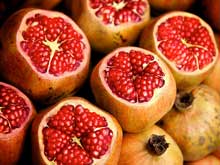Pomegranate is the name of a shrub or small tree that bears fruit of the same name.
Other Danish and Latin names for the pomegranate include:
- Punic apple
- Punica granatum
- Punica Malus
In this article you can read about the characteristics, cultivation and history of the pomegranate.
For additional information, please also see our articles on pomegranate juice and pomegranate oil.

Description of the pomegranate
Characteristics of the plant
- The pomegranate plant:
- Is deciduous
- Grows 6-10 meters high
- Has relatively many branches
- Long-lived (some pomegranates live longer than 200 years)
- Has red flowers that grow in clusters of up to 5 flowers each
Characteristics of the fruit
- The pomegranate fruit:
- Is 6-13 cm in diameter
- Can weigh up to ½ kg
- Has a hard, leathery peel that is yellow, green, brown, pink or red
- Has white, spongy partitions in its interior that separate its many seeds
- The kernels can be red or white and hard or soft
- The single seed is surrounded by white, light red or red flesh that is juicy and tasty (although there are some varieties without seeds)
- The seeds make up around half (52%) of the total weight of the fruit
Growing pomegranates
Growing climate
Pomegranates grow in mild temperate, subtropical and tropical climates, and can grow in dry desert landscapes as well as rainy areas. Although the plant can tolerate temperatures as low as -12°C, it is adapted to regions with Mediterranean winters and hot summers. However, some varieties grow exclusively indoors or in tropical climates (such as the Bahamas and some tropical islands).
Soil conditions
Pomegranate can grow in almost any type of soil; it can thrive in anything from calcareous, alkaline soil to clayey, acidic soil. In the Himalayas in northern India it grows in gravel and in the Atacama Desert in Chile, it grows in some of the driest soils.
Watering
During the growing season, the pomegranate plant needs a lot of watering – especially since pomegranates typically grow in places where it is very hot and dry.
Propagation
Pomegranates are both self-pollinating and cross-pollinating (via insects), and are also very easy to propagate; if you throw pomegranate seeds on loose soil, they will immediately start to sprout.
Propagation can be done in 4 ways:
- Seed propagation
- Cuttings propagation
- Grafting
- Air layering
Insects and fungi
Enemies of the pomegranate include the butterfly Virachola isocrates and Leptoglossus zonatus, which is an insect in the scale family.
In addition, the roots of the pomegranate plant can also be prone to fungal decay in rainy or wet climates.
Nutritional content
Polyphenols
Polyphenols – also known as tannins – are arguably the most notable nutritional value in pomegranates. Polyphenols are a group of antioxidants that are also found in red wine, for example, and help give pomegranates their color and taste. The fact that polyphenols are antioxidants means that they help protect the body's cells from damage and reduce any inflammation in the body.
Vitamin C
Pomegranates contain vitamin C – but not in the high amounts that many health food stores and the like attribute to it. An orange contains about 10 times as much vitamin C as a pomegranate ( 60.8 mg and 6.1 mg per 100 g, respectively). The vitamin C content of commercial pomegranate juice can vary, but if you press it yourself, the content will be intact.
History and origin of the pomegranate
Pomegranates originate from the area around ancient Persia (present-day Iran) and some sources also state that its region of origin extends as far as the Himalayas in northern India (which may include Afghanistan, Tajikistan and Pakistan).
The pomegranate (fruit) has long been used in the same way it is used today – as a food and herbal remedy. It is mentioned in the Christian Bible, the Babylonian Talmud, Egyptian and Greek mythology. Similarly, it was part of Roman culture and is still found today in Hindu and Jewish culture, for example. In the Middle Eastern parts of the world, the fruit was brought by desert caravans for its long shelf life and its delicious and nutritious juice.
The pomegranate reached the southern parts of Iran and India in the first century AD. In 1416, pomegranates were reported growing in Indonesia.
Today, pomegranates grow primarily in Egypt, China, Afghanistan, Pakistan, Bangladesh, Iran, Iraq, India, Burma and Saudi Arabia, and are also grown commercially in Israel and Jordan.
